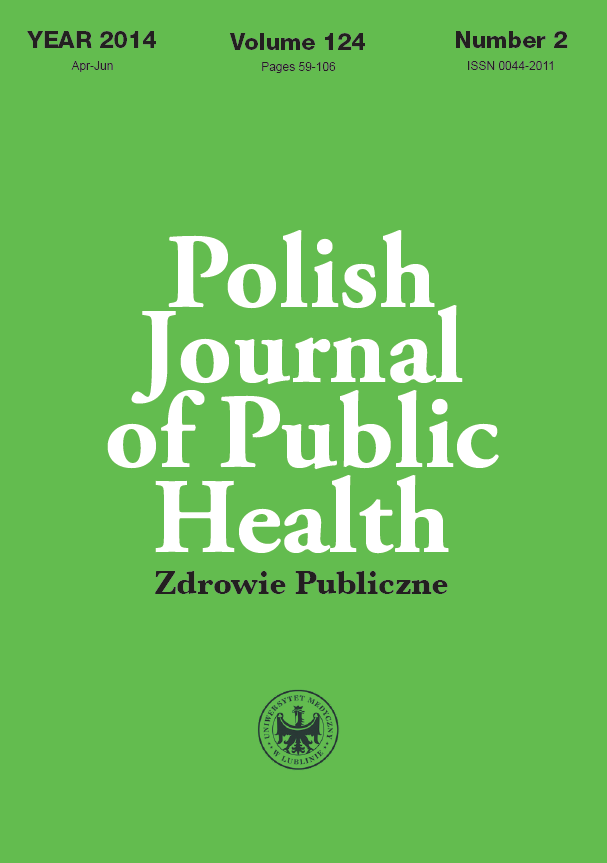Usefulness of composite restoration in direct esthetic closure of midline gap
DOI:
https://doi.org/10.2478/pjph-2014-0020Keywords:
midline gap, diastema, diastema closure, composite restorationAbstract
Introduction. Midline gap (diastema) is a space between two teeth, commonly between two incisors. The treatment can be provided by orthodontic, conservative (restorative) or prosthetic methods.
Aim. The aim of the study was an assessment of using direct composite restoration in aesthetic closing of diastema.
Material and methods. The space correction between teeth was performed among female and male adult patients with diastema of 3 to 6 mm. The microhybrid resin composite was used for the composite build-ups with a help of celluloid or silicon matrix due to its good handling properties and shade matching, and polishability properties.
Results. Depending on the size of diastema, the partial or total closing was done to achieve the cosmetic effect. The obtained clinical results were highly assessed both by dentists and patients. It was possible to obtain optimal aesthetic results with resin composite restorations only.
Conclusions. The simple closure of diastema with direct composite reconstructions can result in successful outcome and patient’s satisfaction.
References
1. Broadbent BH. The face of the normal child. Angle Orthod. 1937;7(4):183-208.
2. Andrews LF. The six keys to normal occlusion. Am J Orthod. 1972;62(3):296-309.
3. Oesterle LJ, Shellhart WC. Maxillary midline diastemas: a look at the causes. J Am Dent Assoc. 1999;130(1):85-94.
4. Huang WJ, Creath CJ. The midline diastema: a review of its etiology and treatment. Pediatr Dent. 1995;17(3):171-9.
5. Delli K, Livas C, Sculean A, et al. Facts and myths regarding the maxillary midline frenum and its treatment: a systematic review of the literature. Quintessence Int. 2013;44(2):177-87.
6. Campbell A, Kindelan J. Maxillary midline diastema: a case report involving a combined orthodontic/maxillofacial approach J Orthod. 2006;33(1):22-7.
7. Gass JR, Valiathan M, Tiwari HK, et al. Familial correlations and heritability of maxillary midline diastema. Am J Orthod Dentofacial Orthop. 2003;123(1):35-9.
8. Rahilly G, Crocker C. Pathological migration: an unusual cause of midline diastema. Dent Update. 2003;30(10):547-9.
9. Onyeaso CO. Prevalence of malocclusion among adolescents in Ibadan, Nigeria. Am J Orthod Dentofacial Orthop. 2004;126(5):604-7.
10. Kokich VO, Kokich VG, Kiyak HA. Perceptions of dental professionals and laypersons to altered dental esthetics: asymmetric and symmetric situations. Am J Orthod Dentofacial Orthop. 2006;130(2):141-51.
11. Marques LS, Filogonio CA, Filogonio CB, et al. Aesthetic impact of malocclusion in the daily living of Brazilian adolescents. J Orthod. 2009;36(3):152-9.
12. Shashua D, Artun J. Relapse after orthodontic correction of maxillary median diastema: a follow-up evaluation of consecutive cases. Angle Orthod. 1999;69(3):257-63.
13. Mattos CT, da Silva DL, Ruellas AC. Relapse of a maxillary median diastema: closure and permanent retention. Am J Orthod Dentofacial Orthop. 2012;141(1):e23-e27.
14. Sullivan TC, Turpin DL, Artun J. A postretention study of patients presenting with a maxillary median diastema. Angle Orthod. 1996;66(2):131-8.
15. Dietschi D. Optimizing smile composition and esthetics resin composites and other conservative esthetic procedures. Eur J Esthet Dent. 2008;3(1):14-29.
16. Lenhard M. Closing diastemas with resin composite restorations. Eur J Esthet Dent. 2008;3(3):258-68.
17. De Araujo EM Jr, Fortkamp S, Baratieri LN. Closure of diastema and gingival reconturing using direct adhesive restorations: a case report. J Esthet Restor Dent. 2009;21(4):229-40.
18. Signore A, Kaitsas V, Tonoli A, et al. Sectional porcelain veneers for a maxillary midline diastema closure: a case report. Quintessence Int. 2013;44(3):201-6.
19. Sapuła M, Wolańska E, Jarmolińska K. Evaluation of operating properties of Filtek Z550 composite material according to Ryge – preliminary report. J Stoma. 2013;66(3):331-40.
20. Tarnow DP, Magner AW, Fletcher P. The effect of the distance from contact point of the crest of bone on the presence or absence of interproximal dental papilla. J Periodontol 1992;63(12):995-6.
21. Hwang SK, Ha JH, Jin MU, et al. Diastema closure using direct bonding restorations combined with orthodontic treatment: a case report. Restor Dent Endod. 2012;37(3):165-69.


